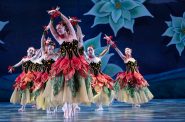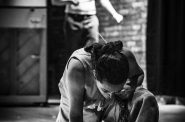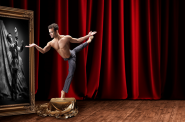Soul dance at the gym
Soul got physical Saturday, in the six bodies of David Zambrano’s international cast of dancers. In their Soul Project, on the Alverno Presents Series, they didn’t merely dance. They channeled the lifeblood of soul music.
Zambrano, clad in an African print tails, plays a ringleader of sorts. He introduces the work as a gallery experience, in a gymnasium theater in the round. The audience can get close to each dancer, in “solo, after solo, after solo, after solo, after…”
A long, lithe male dancer (Edivaldo Ernesto, Mozambique) interrupts. He emerges from the crowd, stammering “Be…careful….it’s…my…heart.” His body alternately pulsates and quivers in sharp, angular shapes. Sometimes, he weaves into the audience.
Likewise, Zambrano welcomes the audience onto the stage. At the MSOE Kern Center, tall black curtains define a large square within the gymnasium. Bright lights, designed by Ellen Knops, beam down yellows, reds and oranges as speakers blast Ike & Tina Turner’s Respect.
We, the audience, are wallflowers for the duration of the song. We stand densely around the perimeter, eyes wandering in anticipation. I feel as if I’m re-living a middle school dance, with all the anxiety of not knowing what to do. After all, we’re in a gymnasium, packed with confused bodies. But this time the DJ’s spinning all soul music, and it doesn’t matter that I don’t have a date. My only allegiance is to the dancers, and theirs to the spirit of the music itself.
Finally, they emerge, circling the empty center in eclectic costumes designed by Mat Voorter in collaboration with Pepa Martinez.
This, like the entire show, is improvised within a predetermined structure. The music plays in random order. Some of the solos are to pre-selected songs; some are to random songs. The order changes in every show.
Zambrano is known for his use of improvisation and for his Flying Low technique which examines the dancer’s relationship to the floor. The dancers are impressively comfortable at all levels – whether suspended on the balls of their feet, sinking into the floor, or throwing their bodies through space until gravity takes over.
These dancers are focused and they are creative. In one vignette, a lone woman (Nina Fajdiga, Slovenia) dressed in polka-dots, reacts to advances by her male counterparts. A lick of the leg, a bite of the arm, a kiss on the lips, a massage of the head all inspire repositioning as her intricate chest and shoulder movements relay the meaning of Bolda De Nieve’s Be Careful, It’s My Heart.
The dancers’ subtle phrases sometimes morph into athletic shoulder stands and somersaults, but this is not about virtuosity. It is about channeling the energy of soul over time through the body.
A man (Horacio Macuacua, Mozambique) in a tribal skirt stands, energy traveling through his feet, up his legs, and through outstretched arms, quivers like a Pentecostal speaking in tongues. He could be Baby Huey singing A Change is Gonna Come, except that his lips aren’t moving – they are smiling widely. His white teeth and the whites of his eyes show as his head shakes, and for a moment he is a Voodoo priest.
In one of the songs, a musician pauses to say, “All music’s got some soul…We gonna talk about some soul music that’s got some grease.” It might be said that all dancers have soul, but that these dancers are truly alive – their soul is visceral, animated, sustained. In his program notes, Zambrano says he wants his dancers to be “continuously alive. On, like a candle.” Their flame never went out.
Dance
-
Milwaukee Ballet Brings Back Orchestra
 Jul 14th, 2025 by Bruce Murphy
Jul 14th, 2025 by Bruce Murphy
-
New Riverwest Company, Production Impresses
 Feb 10th, 2020 by Brendan Fox
Feb 10th, 2020 by Brendan Fox
-
Milwaukee Ballet Show Remakes History
 Feb 10th, 2020 by Catherine Jozwik
Feb 10th, 2020 by Catherine Jozwik





















